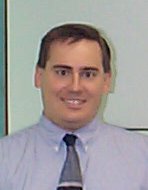

|
'Engineers, geologists and geophysicists work with ideas, technology, information and people. They invent, design, propose, communicate, and develop new processes and technologies. Their work provides them with a high level of responsibility, variety and creativity.'
|
"A
Day in the Life" features stories from APEGGA professionals that provide
a glimpse into what it's really like to work as an engineer, geologist
or geophysicist.
 A
Day in the Life of....
A
Day in the Life of....
John D. Take, P.Eng.
STANTEC CONSULTING LTD.
I've always been fascinated by water-a relationship that started with garden hoses and mud puddles and eventually grew into an engineering career, providing people with the drinking water they need and protecting them from flooding as well.
I entered civil engineering at the University of New Brunswick after seeing a brochure in high school mentioning the water-related aspects of civil engineering. I guess I really liked learning about water because I then completed my Master's degree in Water Resources Engineering at the University of Alberta.
I began my career with Stantec Consulting Ltd. in Edmonton, with three years of non-stop work on water-related projects. I then transferred to Lethbridge to work on a major study of the City's underground infrastructure-water pipes, sanitary sewers, and the stormwater collection system. After two years of working on this, and other projects, I added the responsibilities of running the Lethbridge office to my list. And I found I enjoy working in our small office because of the great variety of work we do-it's hard to get tired of continually working on new and different types of projects.
As a consulting engineer, there are three primary activities that fill my day-business development, project engineering and management, and administration. Each has its set of challenges as well as rewards.
Business development involves marketing and promoting the firm's services and the preparation of detailed proposals that describe how our consultants would solve a problem, who would do the work, and how much it will cost the client.
Project engineering and management is what I enjoy most. This is the nuts and bolts of using engineering tools to solve problems, leading larger teams doing the same, and working with our clients. Administration activities include the day-to-day items involved in running a business-accounting items such as paying bills and issuing invoices, managing the office, and ensuring staff have the resources they need.
There was one day, several weeks ago, that involved good examples of all three of these activities…The day began with a working session to finalize twelve large display boards for an upcoming open house we're holding in conjunction with the City, as part of our Cemetery Development and Management Plan study ensuring Lethbridge's cemeteries are ready for the future. The boards are 3 ft high and 5 ft long, which equals 180 square feet of text, graphics, and content that need to maintain the interest of the public and deliver the message we want. We discuss last minute tweaks to the boards, ensure they will be ready on time, and finalize a questionnaire for those who visit the display. (I've learned a lot I never thought would be part of an engineering career during this project.)
The next task involves preparation of two CD-Rom's of promotional material for our Sacramento, California office. We're using various technologies and expertise from our Lethbridge underground infrastructure study to assist in securing a project south of the border. We check out the multi-media portions of the content, review and make some changes to graphics and text, and then arrange for someone to burn the discs and get them in the courier.
The rest of the morning is spent in a workshop with the City's Public Operations staff, informing them of their role in the upcoming uni-directional flushing program we've designed with the City's engineers. This program will strategically open hydrants and flow water through the system at high velocities to scour the pipes clean, and we need to talk to the field staff who will be opening and closing the valves and hydrants. The junior engineer in our office has worked very hard and does a great job delivering the presentation-it's probably the lengthiest public speaking he's done to date.
When I arrive back at our office, after a quick visit home for lunch, I go over the outgoing invoices with our administrative assistant. We're sending bills to our clients amounting to more than a quarter of a million dollars this month, so it takes a while to review each invoice in detail.
I then head out to the County of Lethbridge airport, where we hold a meeting with the County and Transport Canada about upcoming projects. Several staff from our aviation group are in town from Port Elgin, Ontario, and as part of the meeting, we head onto the runways to visually inspect pavement and lighting systems.
Back at the office, I check in with our summer engineering student-she's been hard at work designing water distribution system flushing loops, and it's important to see how she's doing and if she needs anything.
After I answer the emails that have piled up while I've been away, I get ready for tomorrow's start-up meeting. We're kicking off the engineering and landscape architecture components for the next phases of the City's newest subdivision-RiverStone-and I need to be prepared to discuss an existing irrigation canal that we're going to transform into a creek running through a park.
And so it's been another good day at work. As I head home, I wonder how
it went by so fast.